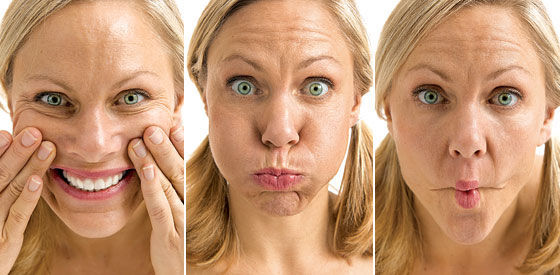
At New York Health & Racquet Club, Annelise Hagen leads Yoga Face students through a series of expressions said to strengthen muscles and reduce sags, wrinkles, and double chins. “The muscles of the face are no different from the muscles of the rest of your body,” she writes in her 2007 book, The Yoga Face. “If you don’t exercise the muscles below your neck, they become weak and flabby, and the same thing will happen to your face with age.” In other words, a regular practice of Satchmo can supplant Botox? In our doctor poll, skeptics outnumber believers.
Dr. Kathryn Frew, Juva Skin & Laser Center
“Repeated facial expressions and muscle movements cause more wrinkling. It will not serve to lift and tone the face. As we age, we lose volume in our face as the fat, muscle, and bone atrophy with time, and the elasticity of the skin decreases.”… … . .
Dr. Elie Levine, Plastic Surgery & Dermatology of NYC
“Beware, in doing facial yoga, not to strengthen the wrong muscles! Sometimes strengthening helps, sometimes weakening them does. That’s the idea behind Botox—to relax facial muscles that cause dynamic, as well as static, facial wrinkles. When exercising the face, it will be hard to isolate just the muscles you want to strengthen.” … … . .
Dr. Steven J. Pearlman, plastic surgeon in private practice
“Yoga masters all have svelte, strong bodies, but often narrow, sallow, drooping faces. In short, gravity sucks.”… … . .
Dr. Jody Alpert Levine, Plastic Surgery & Dermatology of NYC
“So much more goes into a healthy body than just exercise. It requires eating well, exercise, and limiting tension and environmental poisons. In conjunction with a healthy diet, moisturizing, sunblock, and limiting stress, facial yoga may help.”… … . .
Dr. Gerald Ginsberg, medical director, TriBeCa MedSpa
“It’s a great idea for improving complexion and the overall tone of the skin, and to flush out toxins. The exercises work to improve circulation and bring in oxygen, which in turn creates a ‘rosy glow’ on the surface area of the skin … Where I’m willing to say ‘Teach me’ is in the neck area, where the platysma muscle, which affects laxity, could possibly turn back the common ‘turkey neck’ look.” … … . .